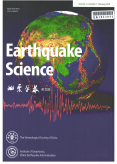- 钛学术文献服务平台 \
- 学术期刊 \
- 基础科学期刊 \
- 天文学、地球科学期刊 \
- 地震学报(英文版)期刊 \
The shallow crustal S-velocity structure of the Longmenshan fault zone using ambient noise tomography of a seismic dense array
The shallow crustal S-velocity structure of the Longmenshan fault zone using ambient noise tomography of a seismic dense array
基本信息来源于合作网站,原文需代理用户跳转至来源网站获取
摘要:
The Longmenshan fault zone(LMSF),characterized by complex structures and strong seismicity,is located at the junction between the eastern margin of the Tibetan Plateau and the north-western Sichuan basin.Since the Wenchuan earthquake on May 12,2008,abundant studies of the formation mechanism of earthquakes along the LMSF were performed.In this study,a short-period dense seismic array deployed across the LMSF was applied by ambient noise tomography.Fifty-two 3-D seismic instruments were used for data acquisition for 26 days.We calculated the empirical Green's functions(EGFs)between different station-pairs and extracted 776 Rayleigh-wave dispersion curves between 2 and 7 s.And then,we used the direct-inversion method to obtain the fine shallow crustal S-wave velocity structure within 6 km depth in the middle section of the Longmenshan fault zone and nearby areas.Our results show that the sedimentary layer(>5 km)exists in the northwest margin of Sichuan Basin with a low S-wave velocity(~1.5-2.5 km/s)which is much thicker than that beneath the Longmenshan fault zone and the Songpan-Garzê block.The high-velocity structures with clear boundaries below the middle of Longmenshan fault zone(~2-4 km)and the Songpan-Garzê block(~4.5-6 km)probably reveal the NW-SE distribution patterns of both the Pengguan complex and the high-density belt hidden in the northwest of the Pengguan complex.And the obviously high-velocity anomalies observed at the depth of ~ 1-2 km in the southeastern margin of the Songpan-Garzê block can be considered as the Laojungou granites.Our results provide a high-resolution shallow velocity structure for detailed studies of the Longmenshan fault zone.

推荐文章
Using seismic surveys to investigate sediment distribution and to estimate burial fluxes of OC, N, a
Dongfeng Reservoir
Seismic survey
Sedimentation
Nutrients burial fluxes
Seasonal shifts in the solute ion ratios of vadose zone rock moisture from the Eel River Critical Zo
Vadose zone
Solute ion ratios
Critical Zone Observatory
Seasonal solute dynamics
Incorporation of silica into the goethite structure: a microscopic and spectroscopic study
Quartz
Goethite
Twinned goethite
Microscopic characterization (FESEM and TEM)
FT-IR spectroscopy
Variation of the Energy Field of Longmenshan Fault Zone before the Wenchuan Ms 8.0 Earthquake
龙门山断裂带
能源领域
地震前
汶川
地震短期异常
地震活动性
唐山大地震
活动断裂带
内容分析
关键词云
关键词热度
相关文献总数
(/次)
(/年)
引文网络
引文网络
二级参考文献 (99)
共引文献 (169)
参考文献 (25)
节点文献
引证文献 (0)
同被引文献 (0)
二级引证文献 (0)
1968(1)
- 参考文献(1)
- 二级参考文献(0)
1975(1)
- 参考文献(0)
- 二级参考文献(1)
1984(1)
- 参考文献(0)
- 二级参考文献(1)
1988(1)
- 参考文献(0)
- 二级参考文献(1)
1990(1)
- 参考文献(0)
- 二级参考文献(1)
1991(1)
- 参考文献(0)
- 二级参考文献(1)
1992(2)
- 参考文献(0)
- 二级参考文献(2)
1993(3)
- 参考文献(0)
- 二级参考文献(3)
1994(4)
- 参考文献(0)
- 二级参考文献(4)
1995(2)
- 参考文献(0)
- 二级参考文献(2)
1997(1)
- 参考文献(0)
- 二级参考文献(1)
1999(2)
- 参考文献(0)
- 二级参考文献(2)
2000(1)
- 参考文献(0)
- 二级参考文献(1)
2001(3)
- 参考文献(0)
- 二级参考文献(3)
2002(1)
- 参考文献(0)
- 二级参考文献(1)
2003(4)
- 参考文献(1)
- 二级参考文献(3)
2004(5)
- 参考文献(1)
- 二级参考文献(4)
2005(6)
- 参考文献(4)
- 二级参考文献(2)
2006(3)
- 参考文献(2)
- 二级参考文献(1)
2007(8)
- 参考文献(2)
- 二级参考文献(6)
2008(15)
- 参考文献(0)
- 二级参考文献(15)
2009(23)
- 参考文献(1)
- 二级参考文献(22)
2010(5)
- 参考文献(1)
- 二级参考文献(4)
2012(3)
- 参考文献(0)
- 二级参考文献(3)
2013(11)
- 参考文献(2)
- 二级参考文献(9)
2014(11)
- 参考文献(5)
- 二级参考文献(6)
2015(2)
- 参考文献(2)
- 二级参考文献(0)
2017(1)
- 参考文献(1)
- 二级参考文献(0)
2018(1)
- 参考文献(1)
- 二级参考文献(0)
2019(1)
- 参考文献(1)
- 二级参考文献(0)
2019(1)
- 参考文献(1)
- 二级参考文献(0)
- 引证文献(0)
- 二级引证文献(0)
引文网络交叉学科
相关学者/机构
期刊影响力
地震学报(英文版)
主办单位:
中国地震学会
出版周期:
双月刊
ISSN:
1674-4519
CN:
11-5695/P
开本:
16开
出版地:
北京民族学院南路5号(北京8116信箱)
邮发代号:
创刊时间:
1980
语种:
eng
出版文献量(篇)
1366
总下载数(次)
0
总被引数(次)
3070
期刊文献
相关文献
推荐文献
- 期刊分类
- 期刊(年)
- 期刊(期)
- 期刊推荐
力学
化学
地球物理学
地质学
基础科学综合
大学学报
天文学
天文学、地球科学
数学
气象学
海洋学
物理学
生物学
生物科学
自然地理学和测绘学
自然科学总论
自然科学理论与方法
资源科学
非线性科学与系统科学
地震学报(英文版)2022
地震学报(英文版)2021
地震学报(英文版)2020
地震学报(英文版)2019
地震学报(英文版)2018
地震学报(英文版)2017
地震学报(英文版)2016
地震学报(英文版)2015
地震学报(英文版)2014
地震学报(英文版)2013
地震学报(英文版)2012
地震学报(英文版)2011
地震学报(英文版)2010
地震学报(英文版)2009
地震学报(英文版)2008
地震学报(英文版)2007
地震学报(英文版)2006
地震学报(英文版)2005
地震学报(英文版)2004
地震学报(英文版)2003
地震学报(英文版)2002
地震学报(英文版)2001
地震学报(英文版)2000
地震学报(英文版)1999

 免费查重
免费查重










